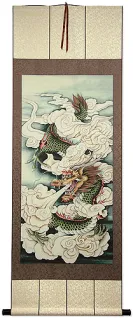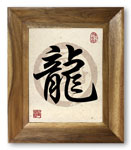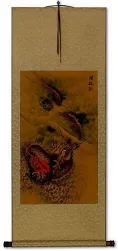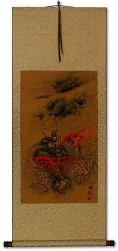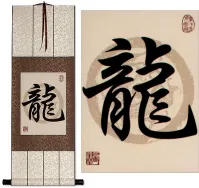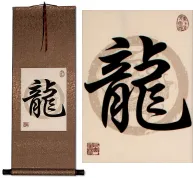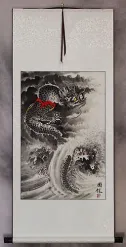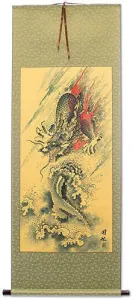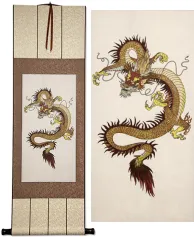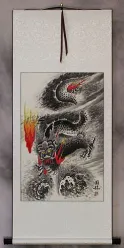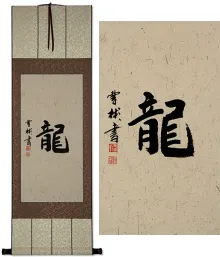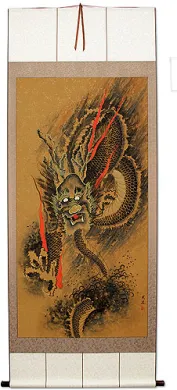DRAGON Chinese / Japanese Calligraphy Scroll
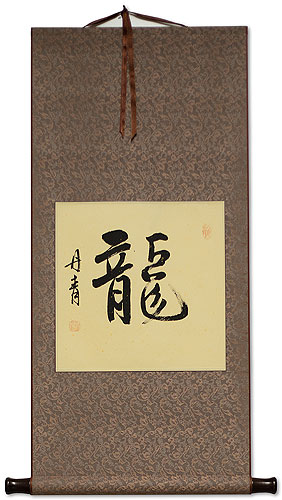

34¾"
19¾"
• Delivered to you in Columbus by Dec 30th.
• Standard shipping is just $3.80 for any order.
• Hand-Painted Calligraphy - Limited Supply.
• Handmade Wall Scroll.
• Money-Back Guarantee.

This calligraphy artwork will look great in your home or office.
Approximate Measurements
Artwork Panel: 32.1cm x 32.1cm ≈ 12½" x 12½"
Silk/Brocade: 41.2cm x 88.2cm ≈ 16¼" x 34¾"
Width at Wooden Knobs: 50.2cm ≈ 19¾"
Information about caring for your wall scrollSee Larger Image
Dragon Symbol
Chinese Calligraphy Wall Scroll
A quick lesson in Chinese Hanzi and Japanese Kanji
The three boxes in the middle below are all forms of
Traditional Chinese Characters often referred to as Hanzi in Chinese, and Kanji in Japanese.
 Simplified Character |
 Printed Calligraphy |
 Typical Calligraphy |
 Typical Handwriting |
 Ancient Official Script |
If you want to open your mind to more, read below...
Examples of the earliest pictographs or hieroglyphics in China date back almost 5000 years. The area now known as China was a fragmented region with various kingdoms rising and falling. Each kingdom or nationality in China had it's own writing system, and could not effectively communicate with people of other kingdoms.
Finally, in about 221 B.C. the Qin Dynasty unified all of China. One of the Qin Emperor's goals was to standardize the writing system across all of his empire.
The official script was the second-generation of writing approved during Qin.
This official script was still very complex to write, with the invention of the printing press still thousands of years away, official scribes literally had their hands full as they penned various documents. Historian will argue this point, but the Traditional Chinese Characters that you see today entered a somewhat final lexicon during the Wei kingdom (220-265 A.D.) and the Jin Dynasties (265-420 A.D.)
The adoption of Simplified Chinese Characters happened under Chairman Mao in the early 1950s in an effort to make it easier for under-educated people to learn to write. However, true calligraphers will only write Traditional Chinese Characters. Places like Taiwan, Hong Kong, Singapore, and several other regions in Asia that were unaffected by Chairman Mao's rule still use traditional characters in day to day life.
Traditional Chinese Characters are known in Japanese as Kanji. In Japan, these characters are used every day in newspapers, magazines, documents, and personal letters. However, they are mixed with Japanese-specific characters called Hiragana, which means a Chinese person trying to read a Japanese newspaper can only get the gist of what the story might be about.
In China, people speak all kinds of languages such as Mandarin, Cantonese, Shanghainese, Tibetan and many other regional languages. When two Chinese people meet, they might not be able to understand each other because they speak different Chinese languages. But they can write down what they are trying to say, and be easily understood thanks to the Qin emperor's dream of a standardized writing system.
Think about this fact:
One third of the world's population can understand the Chinese characters shown above, while only 6% of the people in the world can natively understand the English words that I am writing here.
© 2005 OrientalOutpost.com

This Chinese character is "long" which means dragon.
(Note: This "long" is not English, so the "o" vowel sound is more like "oh" in English)
In Chinese culture, the dragon represents power and for many generations, only the emperor could dare to wear the symbol of a dragon on their clothing.

If you hang this on your wall, it indicates that you are strong and powerful. A great gift for a corporate executive with a chip on his shoulder - lol.
This is probably the most popular Chinese character for tattoos these days. You'll see it on the shoulders of pro-basketball players, and on the hips of pop star divas. Of course, half of them have no idea what this symbol means, and the other half incorrectly think it directly means "warrior" or "power".
Of course, long before it became a tattoo staple, the mythological dragon roamed the earth - at least in the legends and minds of Asian people.
The history of the dragon is hidden deep in myth and history. Drawings and symbols of this mythological animal can be traced back to prehistoric tribal peoples of China. Evidence of the dragon's importance in Chinese culture can be traced to dragon figures and other artifacts unearthed from the Yin Dynasty (3000 years ago).
This piece is painted with special Chinese ink on xuan paper (rice paper) mounted to a traditional gold-colored silk scroll.
Chinese Calligraphy is only practiced by those with a keen and agile hand. It is an art that dates back thousands of years, and great artists, writers, and poets are often admired for their calligraphy ability and style.
The artist's name is "Li Dan Qing" who is from Beijing, China. He is an older man who writes calligraphy for fun in his retirement.
This hanging scroll is really nice since it doesn't require framing. Just hang it on your wall as Chinese people have done for centuries.
This item was listed or modified
Jul 17th, 2022
